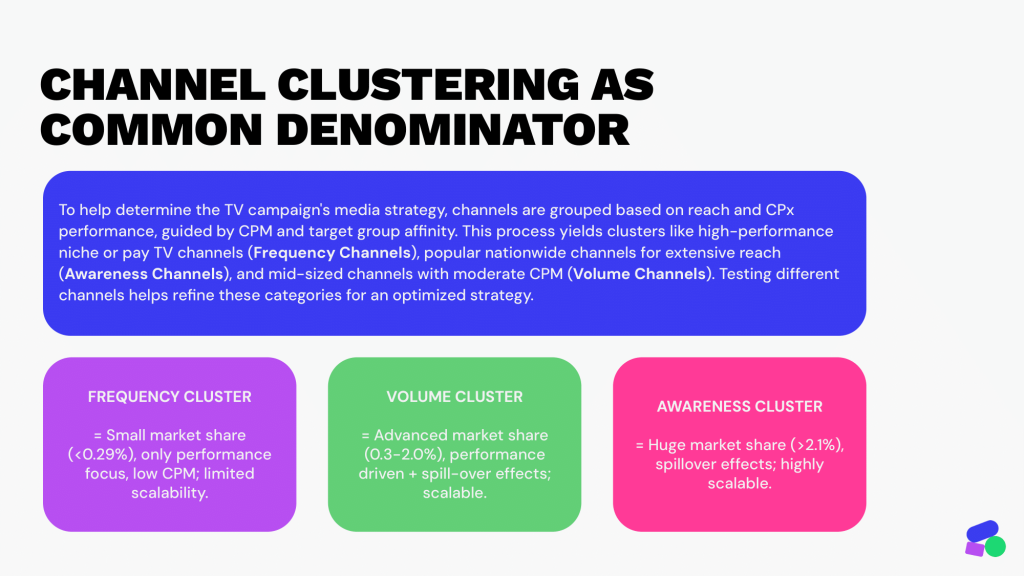Performance TV advertising makes good use of TV’s wide reach to drive measurable business outcomes, similar to digital marketing (same same, but different).
This guide, which was derived from the E-Commerce, Why Not?! podcast hosted by Romy Riffel und Johannes Kliesch together with our COO, Andreas Peltret, covers essential steps and strategies for launching an effective performance TV campaign in Germany.
Setting Objectives and KPIs
Setting clear objectives is crucial for the success of your performance TV campaign. Define specific goals such as increasing website traffic, generating leads, or boosting sales. Discover how TV advertising powers up e-commerce marketing to achieve these goals. Track metrics like Cost Per Thousand Impressions (CPM), Cost Per Acquisition (CPA), and Return on Ad Spend (ROAS) to measure your campaign’s effectiveness. Clearly defined KPIs help in understanding whether the campaign meets your business goals and where adjustments are needed.
Understanding Costs and Pricing
TV advertising can be cost-effective compared to other platforms. Be aware of seasonal variations in TV advertising costs. For instance, Q4 is typically more expensive, but increases are usually around 20%, not double. This cost efficiency makes TV a viable option even for smaller brands looking to expand their reach.
Target Audience and Channel Selection
Identify your target audience based on demographics and viewing habits. Start with smaller, niche channels such as Motorvision and Deluxe Music just to name a few, to test your ads. These channels often provide better performance at lower costs. Once you identify what works, gradually move to larger channels like Pro7 or RTL. However, niche channels often outperform mainstream channels in response rates and acquisition costs, making them a valuable part of your advertising mix.
To help determine the TV campaign’s media strategy, channels are grouped based on potential reach and CPx performance, guided by CPM and target group affinity. This process yields clusters like high-performance niche or pay TV channels like Sky (grouped into Frequency Channels), popular nationwide channels for extensive reach like RTL, Pro7 and ARD (grouped into Awareness Channels), and mid-sized channels with moderate CPM like DMAX, TLC and WELT (grouped into Volume Channels). Testing different channels helps refine these categories for an optimized strategy.

“Include a clear call to action in the last 3-5 seconds of a 10-second ad or the last 5-7 seconds of a 20-second ad.”
Creative Strategy
Shorter ads (10-20 seconds) generally perform well. For instance, 10-second ads have been effective in driving results due to their functionality of being high in frequency and low in CPMs. SNOCKS taught us that User-Generated Content (UGC) spots have shown good performance and are cost-effective (low in production cost and high in response).
Our rules of thumb: include a clear call to action in the last 3-5 seconds of a 10-second ad or the last 5-7 seconds of a 20-second ad. The aim is to drive a response, by directing TV viewers to your website URL, type in your Brand name in the search bar, but keep out the temptation of using QR codes, as they are less effective in Europe.
Mentioning the brand name multiple times during the commercial but keeping the message concise and compelling is key to engaging the audience quickly.
Optimal Timing
Ads tend to perform best during mornings and evenings. Monday mornings and Sunday evenings are particularly effective. Take advantage of lower costs during summer months (June, July, August) and Q5 and Q1 (What is Q5?). Tailor your advertising schedule to align with peak viewing times and audience behavior to maximize impact.
”Use post-purchase surveys to gather additional data on how customers found you.”
Measuring and Optimizing Performance
Measure the impact by analyzing traffic spikes on your website 10 seconds before and after your ad airs. Integrate TV data into your multi-channel attribution model to accurately assess performance. Use post-purchase surveys to gather additional data on how customers found you, ensuring a comprehensive understanding of TV’s impact. This data-driven approach helps in fine-tuning your campaigns for better results. Accurate tracking of TV campaigns is crucial for understanding impact and optimizing results.
Case Studies and Continuous Improvement
Continuously test different formats, channels, and timing to refine your strategy. Be ready to pivot based on performance data, focusing on what works best for your brand and audience. For example, focusing on specific products like boxer shorts if they show higher performance. Adopting a flexible approach allows for ongoing optimization and better alignment with market trends and consumer preferences.
Conclusion
Performance TV advertising can be a highly effective part of your marketing strategy when done correctly. By understanding costs, targeting the right audience, creating compelling ads, optimizing timing, and measuring results, you can maximize the impact of your TV campaigns.
This guide was derived from a discussion our gladtobe COO, Andreas, had with the Snocks team during their E-Commerce, Why Not?! video podcast moderated by the founder Johannes Kliesch. Andreas shares evergreen value bombs as to how performance TV works in Germany and how to navigate through all the channels, which can be watched here in German.













